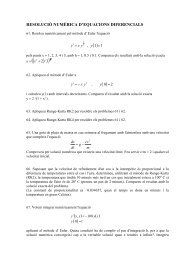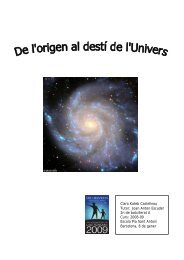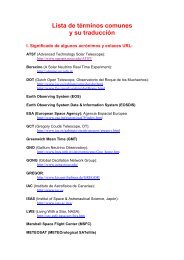Universitat de - Departament d'Astronomia i Meteorologia ...
Universitat de - Departament d'Astronomia i Meteorologia ...
Universitat de - Departament d'Astronomia i Meteorologia ...
You also want an ePaper? Increase the reach of your titles
YUMPU automatically turns print PDFs into web optimized ePapers that Google loves.
16 Chapter 1. Introduction and background<br />
This ratio is always greater than 1, implying that we will <strong>de</strong>tect the approaching<br />
component brighter than the receding one (e.g., see Fig. 1.5). Solving for β cos θ in<br />
Eq. 1.18 we obtain:<br />
β cos θ = (Sa/Sr) 1/(k−α) − 1<br />
(Sa/Sr) 1/(k−α) + 1<br />
. (1.19)<br />
As we have seen, at any given time da > dr. Therefore, if we only have a single<br />
image of an ejection event, the receding component will be closer to the core than<br />
the approaching one. Since the flux <strong>de</strong>nsity <strong>de</strong>creases with increasing distance from<br />
the core (due to adiabatic losses, and assuming no interaction with the interstellar<br />
medium), the measured ratio Sa/Sr will be lower than the one that should be used<br />
in the equation above, which is only valid at equal distances from the core. As a<br />
consequence, in such a case Eq. 1.19 only allows us to obtain a lower limit for β cos θ.<br />
Finally, it may also happen that we have a single image where only the approach-<br />
ing component is <strong>de</strong>tected, either because the relativistic <strong>de</strong>boosting of the receding<br />
one is very strong or because of lack of sensitivity. In any case, we can use the fact<br />
that we do not <strong>de</strong>tect the counter-jet, and replace Sr with the 3σ level of the image<br />
in Eq. 1.19. This will only provi<strong>de</strong> a lower limit to β cos θ, expressed as<br />
β cos θ > (Sa/3σ) 1/(k−α) − 1<br />
(Sa/3σ) 1/(k−α) + 1<br />
1.2.2 Quasars and microquasars<br />
. (1.20)<br />
After the introduction on accretion and the former explanation about special rel-<br />
ativity effects, we can comment on some specific differences between quasars and<br />
microquasars.<br />
In the distant quasars radio emission was <strong>de</strong>tected in the early times of radioas-<br />
tronomy, because the jets in the <strong>de</strong>tected quasars have small angles with respect to<br />
the line of sight, and the flux <strong>de</strong>nsities of the approaching components are signifi-<br />
cantly Doppler boosted. Hence, these objects appear in the sky as very bright radio<br />
sources, showing one-si<strong>de</strong>d jets in high resolution radio interferometric observations,<br />
which usually reveal superluminal motions. The probability of having a quasar with<br />
a jet pointing close to our line of sight is small, but provi<strong>de</strong>d enough number of<br />
quasars, these objects are easy to <strong>de</strong>tect, because their emission is persistent. As-<br />
tronomers searched for the optical counterparts, and found objects that looked like






